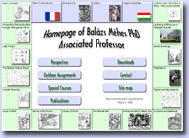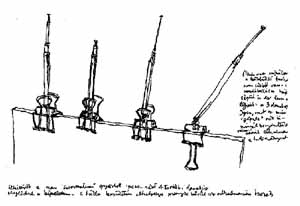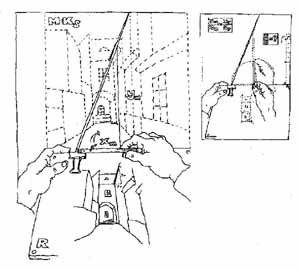

Perspective
Constructions
Outdoor Assignments
Special Courses
Publications
¤ "A New Methodological Approach for Teaching"
¤ Street Drawings
(Third-year students of Buda Castle)
¤ Lecturing in Illinois as a Fulbright Scholar
¤ "Contour-side Opposites of Tone
- the Local Contrast"
¤ Chaos and Order
"A NEW METHODOLOGICAL APPROACH for TEACHING ARCHITECTURAL FREEHAND-DRAWING"* |
||
Key-words: basic structure of linear web, convergence, extreme oblique line, foreshortening, framing shape, judgement by naked eye, main direction, master picture plane, perspective distortion, projection, proportion measuring, proportion meter, reduction, target of observation, sense of proportion, simple line, sight from above, sight from below, view-point, Y-shaped junction. |
||
|
||
I propose the introduction of my new methodological approach called "proportion measuring" in the initial phase of teaching of Architectural Freehand-Drawing, when the teacher needs absolutely the possibility for convincing demonstration of certain critical connections in the view - observed through the pupil's angle of vision. The name of the help developed for this method is "proportion meter". The educative role of my device is to devide the mental process of presentation of space in plane into some decisive steps. This auxiliary instrument supports the development of the sense of proportion and the correct judgement by naked eye through self-control and it proves the critical comments by impartial demonstration. With the help of the "proportion meter" the drawer can temporarily fix certain points or lines -by covering them- on his "master picture plane" which he imagines to be joint to the top edge of his drawing board. During the measuring process he follows the target of observation on this master picture plane, accomplishing the needed comparisons and projections in a suitable chronological order. Who has mastered to transmit in an appropriate proportion the data of his virtual picture plane to his drawing plane, has essentially solved the secret of basic structure of perspective depicting. |
||
|
||
Teaching of basic elements of linear perspective by reductive methods |
||
The way to the oblique lines appearing in the picture plane leads through the simple lines. The subject is: the space, we represent it by the method of projection; the result we produce is: a drawing in plane. We reduce the limiting walls of space to vertical and horizontal planes. We relieve the objects by their framing shapes. Curves should be represented by tangents or chords, curved surfaces should be substituted by covering planes. For the sake of teaching, basic components of our surrounding should be reduced to a simplified "basic structure of linear web". We substitute objects and volumes by simple cubes; we change spaces into an enlarged cube's interior subdivided by quadratic network. The teaching aim of this initial phase is the correct presentation of the basic web - distorted according to the given viewpoint. |
||
|
||
Most important basic phenomena for us are the convergence and the foreshortening (appearing here as sights from above and from below); plus the case of hiding. Examining their effect on the line, we understand that convergence-foreshortening cause mainly an increasing density of lines; and hiding results an absence of lines. |
||
An instinctive approach to basic phenomena of perspective |
||
If an architect-teacher like me, creatively dealing also with arts, becomes really immersed in the scientific theory of perspective, he schrinks soon back from the mass of complicated demonstrations in which the working process (that means the chronological order of construction) can hardly be followed. We, draftsmen, stick less to a scientific background and prefer more instinctive observations, individual experiences aquired with a lot of practice: we better study famous predecessors and work with other patterns. Who can draw a cube even by heart, according to a given viewpoint, masters really the science of perspective. The minimal level of Architectural Freehand-Drawing is the skill of correct presentation of the main directions of space which converge in the cube's corner. We approach to the simulation of depth's illusion from the side of instinctive observation. We delimit ourselves from the omnipotence of vanishing points - because they are often far off from the drawing surface. We shall control convergences afterwards only! |
||
|
||
Pulling down the perspective to simple linear web |
||
From the viewpoint of our rendering goal, we may separate (1) scientific drawing (constructed mainly by ruler and belonging to Descriptive Geometry) and (2) freehand drawing, related to fine arts. Next we carry out the reduction of the perspective picture, leading to simple lines. Let's devide the requisits of our graphical store in two groups: "linear" and "other" means for expressing of distance! Linear drawing might be a contour-drawing, made of simple lines only, enriched later by surface-subdivision and material rendering. Teaching of "lines" is indispensable in drawing-teaching. We analyse the optimal chronological order of web-layers woven of lines, grouping them accordingly to their depth-expressing function. Let's disregard all kinds of "other" depth-creating graphical means, and let's walk backwards from the finished picture to the empty paper! First we take leave of colours, tones; next of other details, surface-subdivisions and material renderings - at last remains the essential basic structure of linear web only! Here the illusion of depth might be mainly expressed by direction and length of lines: operating with condensing or abandoning of lines. In his manual on lines and perspectives, J.P. JUNGMANN calls a picture made entirely of lines as "white graphic". He considers architectural rendering as an optical mechanism, grouping all kinds of graphical effects in drawings according to the mutual mechanism between diverse light conditions, distances, materials, styles and adapted graphical means. In my opinion, we may most economically (with less investment) reach the illusion of depth if we use the simple line web - measuring the result by the total length of lines drawn on correct places within a given time! Our task remains to find these appropriate places only. My present study tries to focus the Reader's attention to this special method for "catching" of oblique lines which express uttermost the illusion of depth. |
||
Traditional Inclination Measuring of Oblique Lines |
||
The traditional "pencil" method for observing of oblique lines and for making realize their virtual inclination could be described as "measuring by straight arm, holding a pencil". In the simple line phase of freehand-drawing, we attach importance to certain line-sections of the sight, compared with each other in an apprpriate chronological order. The advantage of the classic method is that the pencil is always close at hand and stretching one's arm is easily accomplished. Its disadvantage is that it involves many uncertain elements: the distance between the head and the picture plane traced out by pencil is unstable, the line-segment marked with the thumb's nail on the pencil is limited, and thus the sight-detail remains tiny. |
||
The New Approach |
||
The "Proportion Measuring" method can temporarily fix and increase the characteristic data of the observed foreshortening. This happens on the surface of the "Master Picture Plane" which we imagine to be attached to the upper edge of the drawing board. On the Master Picture Plane we exactly accomplish the needed comparison of segments in order to quantify proportions. (That means we find out differences between horizontal and vertical components of the "diagonal" - hypotenuse - in question.) |
||
My "Proportion Meter" developed for this methodological approach is a teaching help for measuring of oblique lines within the basic structure of linear web. By visualizing the (master) picture plane, it clearly surmounts the uncertainties of the "pencil" method. By introducing this help, the connection between the master-picture plane and the correct position of the drawing board, can be understood. If we succeed in developing the special capacities of realizing the comparing choice and the quantifying of proportions in the early stage of teaching; and if we succeed in instructing our students how to "catch" the oblique lines, we may step forward to the next chapter. |
||
|
||
This observation method of dissecting the picture plane, also teaches some kind of chronological order. The teacher can help even his weakest pupil to realize the basic phenomena of perspective, - even without touching his drawing! - when, from the student's viewpoint, he prepares the help's measuring hand by which he determines the virtual position of extreme oblique lines. Auxiliary devices for perspective construction, having been discovered until now, were either too complicated to be ready for practical use, or too simple. The greatest efforts have been made - before the computer's appearance on the scene - in the mechanization of perspective reconstructions using their orthogonal pictures. Freehand-drawing requires few instruments only: the proportion measuring device could complement these at the beginning of the instruction. Its educative role lies in demonstrative guiding and in practising of observation, to sum it up: in teaching how to see. In my opinion, nothing can substitute one's inborn ability to judge proportion by naked eye: however, in order to develop and to improve it, any new method promising some success should be allowed. |
||
*Revised in 2oo4 for Freehand Drawing Course ont he basis of my article published in the "Új Magyar Építőművészet" ("New Hungarian Art of Architecture"), a Cultural Periodical of the Society of Hungarian Architects, Budapest, Hungary - 1998/6, p. 59-61, column "Teaching"
|
||
© All rights reserved Associated Professor Balazs Mehes PhD recommended resolution 1024×768 |
||


%20illusztracio%20a%20Kockavi_kis.jpg)


_kis.jpg)
